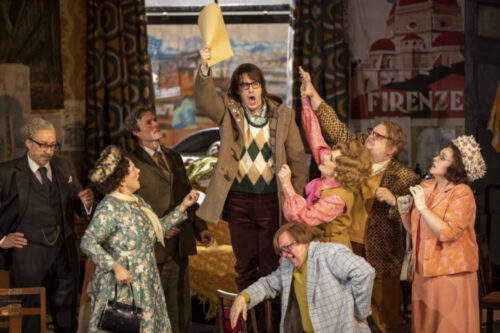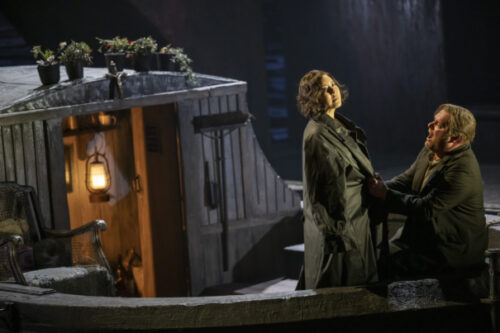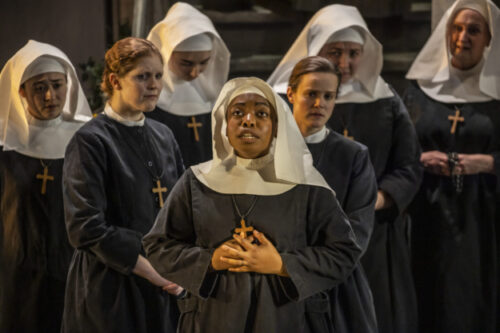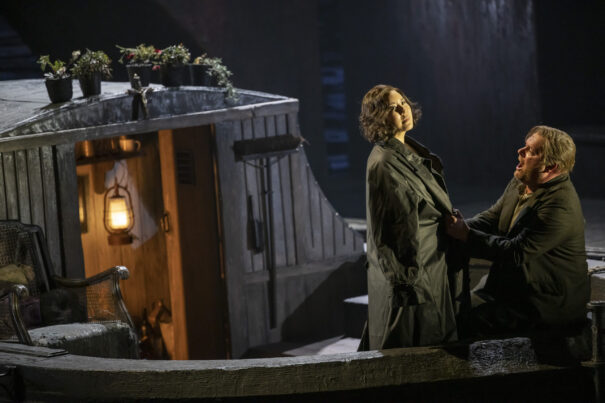 United Kingdom Puccini, Il trittico: Soloists, Chorus (tenors and basses, Il trittico) and Orchestra of Scottish Opera / Stuart Stratford (conductor). Theatre Royal, Glasgow, 15.3.2023. (GT)
United Kingdom Puccini, Il trittico: Soloists, Chorus (tenors and basses, Il trittico) and Orchestra of Scottish Opera / Stuart Stratford (conductor). Theatre Royal, Glasgow, 15.3.2023. (GT)

This is the first complete performance of Puccini’s triptych by a professional company in Scotland since 1957 when Sadler’s Wells Opera brought it to Glasgow for a single evening at the King’s Theatre. The conducting then was shared between Marcus Dods and Alexander Gibson (then the musical director) with David Ward, and William McAlpine among the cast. Yet Scottish audiences had seen Gianni Schicchi in 1923 when it was performed by the British National Opera at the Theatre Royal. It was not until 1969 that the Edinburgh International Festival heard Gianni Schicchi when an opera company from Florence visited and the leading role was given by Tito Gobbi. The Royal Scottish Academy of Music and Drama staged a complete Il trittico in 1975 starring young singers such as Isobel Buchanan, Linda Finnie, and Alan Oke over four evenings at the Atheneum Theatre.
Puccini’s original conception for Il trittico was to use themes from Dante’s Inferno however by the time the works came to the stage, the idea had lost its momentum albeit each opera features death as a central element. Another association from Dante is that in all three operas there are portrayed deceit, greed and corruption in the central characters – Michele (Giorgetta’s husband), the Princess (Angelica’s aunt), and the dead aristocrat Buoso and his relatives in Gianni Schicchi. Scottish Opera’s production is a collaboration with Welsh National Opera and this evening was the second in a run of three shows in Glasgow after which it tours to Edinburgh’s Festival Theatre.
The opening of Il tabarro is set on the banks of the Seine, where we see a barge and the crew unloading wine crates. In the background is a bridge, and scaffolding, while the focus is the wharf, where the action proceeds. The mood is forbidding and intimidating as the barge owner Michele smokes his pipe watching the crew at work while his wife hangs out her washing. The atmosphere hints at a forthcoming debacle as we see on the bridge joyful couples and a cheerful street seller, yet on the wharf, there is an ominous sense of tragedy. At the musical core of this staging is the young Korean soprano Sunyoung Seo, who showed complete identification with a woman torn between her lazy greedy husband and her lover, the young Luigi. Seo’s voice is extraordinary in reaching with ease the highest notes, and in revealing soft dulcet tones. Most significant is her charisma on stage – one is drawn to her – through her movement, facial expression and, no less, her glittering soprano. Luigi is the Russian-born Viktor Antipenko, whose successful characterisation is entirely through his splendid tenor: he possesses a wide vocal range displaying both craving and lust mixed with caution and fear. This marks his debut here, and one hopes this will be the first in many performances in Scotland.

Giorgetta’s husband Michele was expertly characterised by Roland Wood, exposing every nuance of the vengeful barge owner’s selfishness and deceitfulness. Louise Winter as La Frugola voiced with her creamy mezzo all the qualms of a woman fearing for her husband. The action was well handled throughout, and the final tragedy was dramatic and shocking.
The set for Suor Angelica is a simple interior of the convent in light blue, with a staircase dominating the hallway. On the left is a small window allowing the sunshine to enter, while on the right, above the chapel entrance, is the image of the Holy Mary. Sunyoung Seo reappears as Sister Angelica and in voice and personality dominates every scene in this tragic opera. Sister Genovieffa – splendidly characterised by Francesca Chiejina – draws our attention when she goes to the window wanting to see the sun shining on the garden below – and her beautifully sung aria marks her out as a star of the future. At the centre of the plot is the entry of Karen Cargill’s Princess, who presents a comprehensive portrayal of the evil aunt wishing to take away Angelica’s inheritance while telling of Angelica’s dead son. Rather than a sentimental portrayal this is a terribly realistic dramatisation of humanity’s wickedness. Seo’s aria ‘Senza mamma’ is heart-rending in emotion and sensitivity. In the final scene when Angelica is reunited with her son, the audience does not know if her son has been revived or if they are in heaven.

Gianni Schicchi allows us to end the evening with fun and celebration; the set is the bedroom of the wealthy aristocrat Buoso Donati in Florence in sixties Italy, where at centre stage he is on his deathbed. Buoso is surrounded by his relatives desperate for access to their inheritance. In the room are bottles of whisky, cognac and gin and an old telly surrounded by huge bookshelves of old papers and books. The mood is as if we are in a Marx Brothers farce – lacking only Groucho and Harpo – with everyone taking part in a ludicrous entertainment trying to discover Buoso’s will. Books and papers are thrown about in their desperate search for the final will, before they allocate poor Buoso’s properties among themselves writing a fake will. Amongst the characters, it is the show-stopping aria of Francesca Chiejina as Lauretta (‘O mio babbino caro’) which highlights the talent heard earlier in Suor Angelica. Rinuccio’s ‘Firenze e come un’albero fiorito’ arioso was magnificently voiced by Osian Wyn Bowen, another star of the evening. The final duet between the two lovers, Lauretta and Rinuccio, brought this performance to a joyful, celebratory climax after Gianni Schicchi magnanimously hands over the inheritance to the couple. The masterful direction by Gareth Mole and Raymond Short of the movement on stage was part of the enjoyment in this final opera of Puccini’s Il trittico.
The production represents another triumph for the entire Scottish Opera ensemble, with excellent set designs by Charles Edwards and the costumes by Hannah Clark making this complex triple bill come to life. Their work was marvellously complemented by the Ben Pickersgill’s lighting design, finding the realistic atmospheric nuances for each opera. (All three were making their debut with Scottish Opera). Stuart Stratford was superb at the rostrum handling the complex shades of Puccini’s three differing scores to bring out the modernism of Il tabarro through to the gorgeous harmonies of Tuscan passion in Gianni Schicchi. This production was all masterminded by Sir David McVicar who conjured yet another success for the company here in Glasgow. The production moves to the Festival Theatre, Edinburgh for performances on 22 and 25 March.
Gregor Tassie
Production:
Director – Sir David McVicar
Set designer – Charles Edwards
Costume designer – Hannah Clark
Lighting designer – Ben Pickersgill
Movement director – Gareth Mole
Associate Director – Greg Eldridge
Fight director – Raymond Short
Casts:
Il tabarro
Michele – Roland Wood
Giorgetta – Sunyoung Seo
Luigi – Viktor Antipenko
Talpa – Julian Close
Tinca – Jamie MacDougall
La Frugola – Louise Winter
Song Seller – Osian Wyn Bowen
Young Lovers – Francesca Chiejina, Elgan Llyr Thomas
Street Walker – Grace Maria Wain
Suor Angelica
Sister Angelica – Sunyoung Seo
The Princess – Karen Cargill
The Abbess – Sioned Gwen Davies
Sister Genovieffa – Francesca Chiejina
Mistress of Novices – Karen Murray
Novice – Zoe Drummond
The Sister Monitor – Lea Shaw
Sister Osmina – Catriona Clark
Sister Dolcina – Jane Monari
The Infirmary Sister – Heather Ireson
Young Child – Oliver Stout
Gianni Schicchi
Gianni Schicchi – Roland Wood
Lauretta – Francesca Chiejina
Buoso Donati – Keith MacPherson
Zita – Louise Winter
Rinuccio – Osian Wyn Bowen
Simone – Julian Close
Marco – James Cleverton
La Ciesca – Sioned Gwen Davies
Gherardo – Jamie MacDougall
Nella – Maire Flavin
Betto di Signa – Benjamin Bevan
Maestro Spinelloccio – Richard Suart
Ser Amantio di Nicolao – Timothy Dickinson
